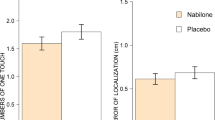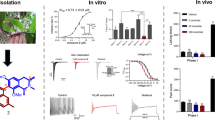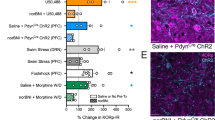Abstract
SINCE nalorphine was demonstrated to have potent analgesic properties1,2 and to be non-addicting in man3, a considerable effort has been directed towards finding narcotic antagonists with similar activities, but without the undesirable psychotomimetic effects produced by nalorphine4. This effort has been complicated by the fact that nalorphine not only is inactive in most analgesic tests in animals, but also will antagonize the analgesic activity of most narcotic drugs5. Only the rat flinch-jump test of Evans6 has been reported capable of detecting the analgesic activity of nalorphine. This finding, however, has yet to be reported by other workers.
This is a preview of subscription content, access via your institution
Access options
Subscribe to this journal
Receive 51 print issues and online access
$199.00 per year
only $3.90 per issue
Buy this article
- Purchase on SpringerLink
- Instant access to full article PDF
Prices may be subject to local taxes which are calculated during checkout
Similar content being viewed by others
References
Lasagna, L., and Beecher, H. K., J. Pharm. Exp. Therap., 112, 356 (1954).
Keats, A. S., and Telford, J., J. Pharm. Exp. Therap., 117, 190 (1956).
Isbell, H., Fed. Proc., 15, 442 (1956).
Keats, A. S., and Telford, J., J. Pharm. Exp. Therap., 119, 370 (1957).
Woods, L. A., Pharmacol. Rev., 8, 175 (1956).
Evans, W. O., Psychopharmacologia, 2, 318 (1961).
Harris, L. S., and Pierson, A. K., J. Pharm. Exp. Therap., 143, 141 (1964).
Keats, A. S., and Telford, J., J. Pharm. Exp. Therap., 143, 157 (1964).
Lasagna, L., DeKornfeld, T. J., and Pearson, J. W., J. Pharm. Exp. Therap., 144, 12 (1964).
Weiss, B., and Laties, V. G., J. Pharm. Exp. Therap., 143, 169 (1964).
Siegmund, E., Cadmus, R., and Lu, G., Proc. Soc. Exp. Biol. and Med. N.Y., 95, 729 (1957).
Hendershot, L. C., and Forsaith, J., J. Pharm. Exp. Therap., 125, 237 (1957).
Litchfield, J. T., and Wilcoxon, F., J. Pharm. Exp. Therap., 96, 99 (1949).
Author information
Authors and Affiliations
Rights and permissions
About this article
Cite this article
TABER, R., GREENHOUSE, D. & IRWIN, S. Inhibition of Phenylquinone-induced Writhing by Narcotic Antagonists. Nature 204, 189–190 (1964). https://doi.org/10.1038/204189a0
Issue date:
DOI: https://doi.org/10.1038/204189a0
This article is cited by
-
Quelle est la validité conceptuelle des tests et modèles animaux de douleurs ?
Douleur et Analgésie (2012)
-
Regard critique sur les modèles animaux de douleur aiguë
Douleur et Analgésie (2001)
-
Profiles of Activity in Rodents of Some Narcotic and Narcotic Antagonist Drugs
Nature (1969)
-
Effects of morphine and nalorphine on the phenylquinone-induced syndrome in monkeys
Psychopharmacologia (1969)
-
Analgesic and other actions of morphine antagonists
Naunyn-Schmiedebergs Archiv f�r Pharmakologie und Experimentelle Pathologie (1968)



